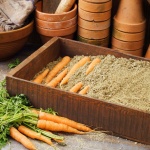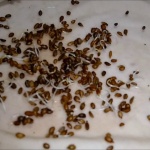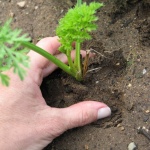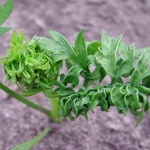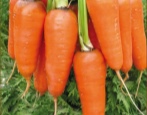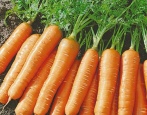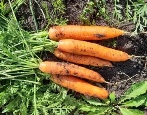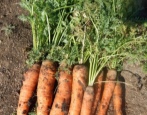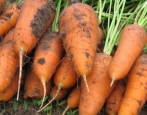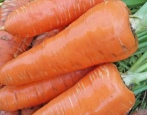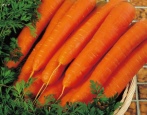
- Appointment: for fresh consumption, for canning
- Weight, g: 150-170
- The form : conical
- Taste qualities: excellent
- Ripening terms: late ripening
- The size : large
- Length, cm: 20
- Bark coloration: orange-red
- Resistance to flowering (shooting): stable
- Yield: high
If there is not enough experience in growing vegetables in a garden ridge, then it is better to choose varieties with simple agricultural techniques that can grow in different climatic conditions. These characteristics are endowed with the mid-late MO carrot variety, bred by Russian breeders.
Description of the variety
The MO carrot is a powerful rosette with semi-spreading leaves. The length of the tops is moderate - up to 25-35 cm in height. The leaves are colored emerald green and have pronounced mid-cut edges. The foliage does not have a deep and unpleasant aroma. The MO carrot belongs to the Chantenay cultivar. Due to the fact that the matured specimens protrude slightly above the surface of the soil, harvesting is not difficult at all.
Characteristics of the appearance of the plant and root crops
MO is a bright and tasty representative of large-fruited varieties. Root crops ripen leveled and neat, so the variety is massively grown by farmers for commercial purposes. The average tuber weight is 150-170, and sometimes 190-200 grams. The length of the root crop reaches 20-22 cm, and the diameter is 4-5 cm. The shape of the carrot is conical with a rounded "nose". The bark of the vegetable is thin, perfectly smooth, with a pronounced gloss, without noticeable eyes, but with small filamentous roots. A ripe root vegetable is evenly colored in a bright orange or orange-red color.
This variety is characterized by good transportation without significant losses, as well as long shelf life - up to 6-7 months if the storage conditions are observed: + 2 ... 4 degrees, dryness.
Purpose and taste of tubers
MO carrots are famous for their great taste. The bright orange pulp is tender, moderately dense, crunchy and very juicy. There is practically no core in carrots. The taste is dominated by sweetness and light sugar content, which is perfectly combined with a pronounced carrot aroma. Carrot pulp contains 10% sugars and about 20% carotene.
The harvested crop has a wide range of uses in cooking - the vegetable is eaten fresh, added to cold and hot dishes, pickled, frozen, and also used for processing on mashed potatoes and juices. Carrots are ideal for dietary and baby food. In addition, vegetables are suitable for winter storage.
Maturation
MO is a late-ripening variety, the growing season of which lasts more than 4 months - 125-150 days. You can taste the root vegetables in the second half of August, and the massive harvest takes place in September-October.
Yield
This variety is declared as a high-yielding variety. If you provide the vegetable crop with sufficient care, then an average of 4.2-6.5 kg of crunchy root vegetables can be dug out from 1 m2 of plantings.
Growing and care
The vegetable is grown through direct sowing of seeds. For this, a site is prepared in advance on which elongated grooves up to 3 cm deep are made, where carrot seeds are sown. The distance between the rows should be 15-20 cm. It is recommended to treat the seeds with a growth stimulator before sowing. Sowing is carried out from late April to mid-May, when the air and soil have warmed up enough. After sowing, the bed is abundantly moistened.
It is also worth noting that the variety is suitable for winter sowing. The procedure is carried out in late October - early November. Seeds are sown in conditions of temperature stability + 3 ... 4 degrees.
The agricultural technology of vegetable crops consists of a chain of standard measures: regular irrigation with settled water, fertilizing twice during the growing season, weeding and loosening the soil, thinning (2 times per season), observing the distance between plants 5-6 cm, prevention of viruses and insect infestations.
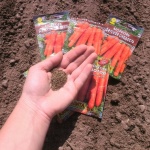
Carrots are one of the most unpretentious crops in terms of growing conditions; they can endure a short drought and a short cold snap. However, to get tasty and large root crops, you should adhere to the basic rules for planting carrots.

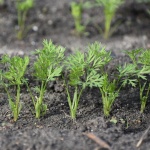
Soil requirements
The vegetable has no special requirements for the structure and quality of the soil, but the more nutritious and better the soil, the more productive the culture. MO carrots prefers loose, fertile and breathable soils with a neutral acidity index. Light loamy and sandy loam soils with sufficient moisture are optimal.
Required climatic conditions
MO carrots have good stress resistance, so the vegetable perfectly tolerates short-term drought, small temperature fluctuations and short shade. Despite this, the site for planting is sunny, warm and bright. The best place is considered to be a flat or slightly elevated area without swampiness and dampness.
Disease and pest resistance
The vegetable has good immunity. This is what provides the culture with resistance to a number of diseases that hinder growth, development and high productivity. The variety is resistant to powdery mildew and cercosporosis. It is extremely rare that a plant is attacked by a carrot fly and a bear, which preventive treatments will help get rid of. In addition, carrots are resistant to flowering (shooting) and fruit cracking.
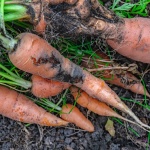
Carrots grow in almost any garden. There is an opinion that this culture is very resistant to all kinds of diseases and pests, but this is not the case. Without proper care, carrots become susceptible to all kinds of infections and are affected by harmful insects.

